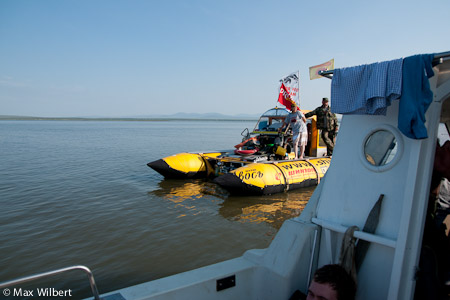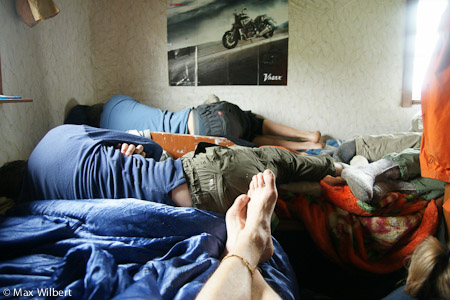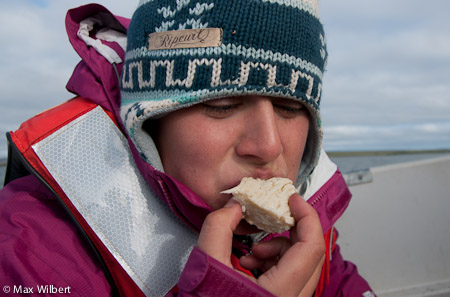We left Saturday morning on what we imagined would be a long, hard day trip to the Arctic Ocean and tundra. We ended up weathering a storm in a fishing shack, relying on Nikita and Sergei’s resourcefulness and our positive attitudes. From this adventure we learned some important lessons on how to survive a trip to the Arctic Ocean.
1. Keep your eyes peeled
We took off towards the north in three boats. Traveling down the Kolyma, we saw beautiful mountains, boreal forests, small towns and refineries. The strangest thing we came across was a car floating down the river. It was suspended between two large yellow inflatable tubes. Two men were riding on the car-pontoon-boat; one laying on the roof and the other steering with a 30 horsepower outboard motor. We laughed at the absurdity of the sight, but as we continued north we passed another car and a van floating in a similar manner. When we attached to Zimov’s large grey boat to refuel, there were passengers who were filming the progress of the trip. Apparently these three vehicles started in Yakutsk on June 1st, drove to the head waters of the Kolyma and are making their way to the Arctic Ocean. After the weather we experienced, we hope that they are safe and still floating.
As we approached the mouth of the Kolyma, the horizon was dotted with white chunks. Since we were entering the Arctic Ocean, we immediately assumed it was sea ice. Jorien, our seasoned ocean explorer, explained that what we imagined as sea ice was actually a fata morgana, a mirage on the horizon. We quickly learned that we couldn’t trust that the islands we were seeing were really there; at this point we were in the Arctic Ocean, north of us was the north pole and Canada beyond. The ocean was reflecting the sky, creating phantom islands that were always out of our reach.
Because of our skepticism we almost missed the herd of reindeer running along the coast. Using binoculars and camera lenses, we strained to decipher what made up the moving brown blob. Once it was a confirmed reindeer sighting, Nikita raced the boat at maximum speed to the herd. We jumped out as fast as we could, most of us neglecting our shoes, and raced up the drift wood and mounds of eroding dirt to reach the tundra plateau. The sight was breathtaking; at least two thousand reindeer grazing, and moving along under the watchful eyes of indigenous herders.
Blinded by our joy at seeing such a large herd, we failed to see the shallow water at the mouth of the Kolyma. First Speedy, the large white boat, was beached on a sandbar. The boat with the forty horse power engine got stuck trying to save Speedy. And the smallest boat tried to stay away but was pushed onto a separate sandbar. In order to get out, Nikita and Max Holmes braved the cold water and pulled the boats across the mud back into deeper water. We cautiously drove away, keeping our eyes peeled for shallow water and logs floating down the river.
2. Watch where you step
Our first stop on our trip north was Ambarchik, a weather station inhabited by one family with ten children. The views of the ocean and tundra were beautiful, but everyone was focused on their feet. Broken glass, barrels, rusty nails and the occasional carcass littered the ground. All of this debris is leftover from Ambarchik’s previous life as a Stalinist prison camp – a gulag. Among the rusty barrels was a cross commemorating the victims of political oppression.
There were also natural hazards. We had to be careful not to slip on the ice on the edge of the snow patch. There we were, at sea level, on July 24th, having a snowball fight with the last remnants of winter snow. The director of the weather station told us that the sea ice receded only a month before. It is hard to imagine how long their winter must be at the edge of the world. We took advantage of being there during their brief summer to swim in the Arctic Ocean. Remarkably it was warm enough to swim around in the ocean and stand in our bathing suits while we dried off.
Our second stop was at the mouth of the Sukharnaya River. Looking out across the tundra, it appeared perfectly flat for miles; we had passed the tree line 50 kilometers to the south. However, the tundra is treacherous for ankles. With each step, the hummocks tip twisting your ankle in every direction. We had to tread carefully to avoid hurting ourselves.
3. Keep your feet dry
Wet feet= squishy socks, in squishy boots, on top of squishy moss; not a pleasant experience (especially if you have cotton socks and are losing all your body heat). Despite our group’s massive investment in rubberized footwear, a miss-step while walking through the tundra can result quickly in an over-topped boot or a quick dive into a stealthy fen (wet grassland hole). Difficult walking through the tundra- but your feet might never be dry again.
4. Bring a fishing rod
At the Sukharnaya we hiked to Zimov’s secret fishing spot. The water was remarkably clear and pure – delicious to drink. Immediately people jumped in to swim, collect water samples and pick bugs. Bill discovered that the caddisflies that covered every rock the past two years were nowhere to be found; a result of the unusually warm summer. Fishing rods provided entertainment; many people tried casting, some more successfully than others, while others gracefully fly fished. We caught ten Arctic Grayling. Melissa cut out chunks of their muscles so she can run isotope analysis on the fish to see what they are eating. We thought that the grayling would be a nice addition to whatever warm meal Valentina, our cook, had waiting for us at the barge. Little did we know we would not be making it home that night.
5. Wear layers
At the mouth of the river, the weather can change very quickly. Hiking back from the Sukharnaya, we were sweating across the tundra, but in a matter of seconds the wind picked up and the temperature dropped 30 degrees. The gorgeous sunset on flat water turned into a gray sky above white caps. We gathered on the beach and dug through our back packs to find our jackets that a half hour before we laughed at ourselves for bothering to carry.
Bundled in every layer we owned, we waited on the beach while Nikita and Sergei assessed the weather situation. Next thing we know, they race off in the boats, leaving us wondering when the would return. But being the proactive people we are, the group did not sit idly. Instead we built Polaris Town; a marvelous shelter of driftwood and a fire to dry our socks and smoke one of the grayling.
The weather had worsened, and it was clear we were not going to make it back to Cherskiy. Nikita returned and instructed us to walk the two kilometers down the beach to a nearby “settlement”.
Our shelter for the night was a winter fishing lodge, a well insulated building with five beds around a wood stove and small kitchen/ dining room with a propane stove. With twenty two people crammed inside, the layers came in handy as pillows and blankets as people covered every surface to sleep. Sleep might not accurately describe the experience for everyone; some people snored loudly while others closed their eyes and struggled to stay warm.
6. Eat whatever is available
During the day we were amazed at the amount of food we had brought along; boxes of chocolate bars, a whole block of cheese and bags of salami. However, when the weather turned and it was not clear when we would be able to leave, food anxiety started to climb. The cookies we took for granted the day before were now the staple of our diet. Zimov dug into the emergency food supply at the fishing lodge and prepared a spaghetti dinner; pasta boiled with five cans of cow meat. Some students remarked at how buttery the pasta was, but there was no butter… just lard. Usually we would be disgusted by this level of grease, but we were now in survival mode, and any calories were fuel.
The next day we napped, sat around a fire on the beach and explored an ice wedge while waiting for an estimated time of departure. We all feared that the only food would be a repeat of the previous night’s dinner. Instead, Kate whipped up a delicious feast of rice with arctic grayling, which we supplemented with more cookies and chocolate.
The best treat that we had was speggy-wedge, a breakfast reincarnation of the spaghetti dinner Valentina prepared before we left. Speggy-wedge is noodles mixed with egg, milk and butter, baked into pie form and cut into wedges. Many people eschewed the clammy, congealed mass but others saw its beauty. The group was in separate strands, but mixed with the egg of our adventures, the fat of our food and baked in that small shack, we have congealed into a cohesive wedge.
7. Always trust Sergei and Nikita Zimov
We owe our safe trip to Sergei and Nikita who carried twenty pieces of luggage (Zimov’s description of us passengers) to the Arctic and back, giving us the adventure of a lifetime and bringing us home again, safe and sound.
– The Polaris Team















Comments(4)-
-
-
-
Drc says
July 25, 2010 at 9:31 pmWow. Wow+wow
andy says
July 26, 2010 at 10:33 amAmazing Max!
Max Holmes says
July 26, 2010 at 3:32 pmIt was remarkable how calm everyone remained throughout this adventure. When we were standing on the beach and the weather turned bad, instead of fretting everyone chipped in to build a fire and a shelter. Instead of complaining about the tight accommodations when we reached the fish camp, people laughed and sang. And when the weather finally cleared enough to head home the following evening, everyone bundled-up and braced for a potentially very cold and wet trip (which turned out to be relatively mild). I’m proud to be associated with this fine group of people.
Thoren says
July 27, 2010 at 10:30 pmWhat an amazing story and artfully told. Can’t wait to see the experienced survivalist in the flesh again. Glad you’re safe and hope you are sleeping well now.